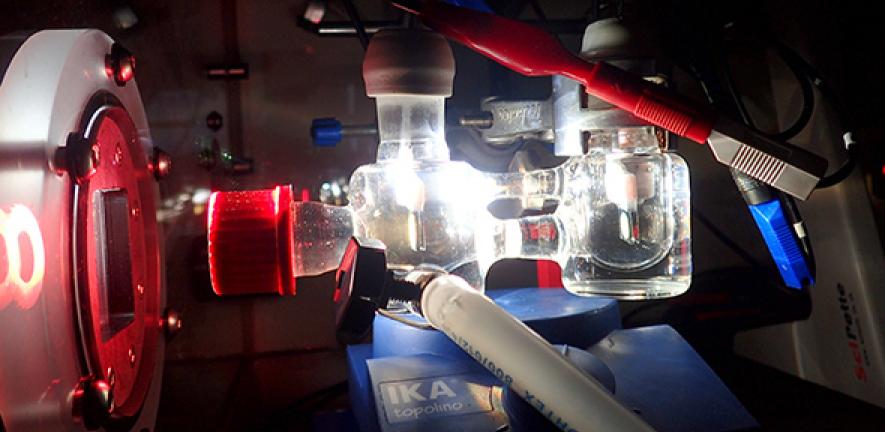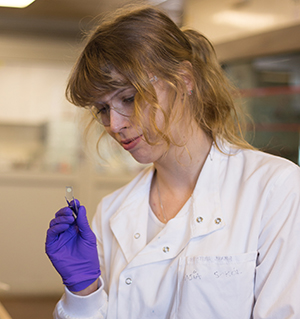
Their model system, described 4 September in the journal Nature Energy, paves the way for new methods of producing sustainable fuels in future.
The model the researchers have developed uses two complementary light-absorbing substances – a naturally-occurring protein and a synthetic dye – in tandem and wires them to a catalyst. This catalyst, hydrogenase, takes the energy from the absorbed solar light and uses it to split water to produce hydrogen.
Hydrogen is of particular interest as a potential sustainable fuel as it can be transformed into a renewable, non-polluting and zero-emission energy resource.
In addition, the researchers (including collaborators at Ruhr-Universität Bochum, Germany) say that now they have demonstrated that their novel energy conversion platform works, it could be developed further for use in a range of ways – for example, converting carbon dioxide into liquid fuels like butanol, a potential future 'green gasoline'.

"This is a milestone in semi-artificial photosynthesis," says Professor of Energy & Sustainability Erwin Reisner about this work, much of which was carried out by his PhD student Katarzyna Sokół. "It overcomes many difficult challenges associated with integrating synthetic materials with biology, and gives us a bigger toolbox for developing future semi-artificial systems for energy conversion."
Photosynthesis is the naturally-occurring energy-conversion mechanism by which plants make food. It is a chemical process in which plants use sunlight to fuel the conversion of carbon dioxide in the atmosphere into sugars that their cells can use for energy. It also creates oxygen as a by-product.
Scientists working in the field of renewable energy are interested in photosynthesis as it is a way to store sunlight in chemical energy carriers. However, natural photosynthesis has limitations as plants are focused on converting carbon dioxide into sugars, like glucose, rather than into a useful fuel for humankind. So researchers are developing a new branch of science called semi-artificial photosynthesis to overcome Nature’s shortcomings.
"Semi-artificial photosynthesis combines extremely efficient natural catalysts – like the enzyme Photosystem II, the protein responsible for all of the oxygen we have in our atmosphere – with synthetic or artificial elements to make the process more effective," says Katarzyna.
In her model system, she first replaced the natural light absorber Photosystem I – which in a leaf would normally compete for light with Photosystem II – with a synthetic dye. This also absorbs light, but at different wavelengths to Photosystem II. "So it’s not competing for light, but offering complementary light absorption," Erwin explains.
In a second step, Katarzyna then wired up these two light-absorbing substances to a photoelectrochemical device that directed all their absorbed light energy into the production of hydrogen, instead of into the conversion of carbon dioxide into sugars as would normally happen in a leaf.
"The novelty in our work lies in the way we are bringing different approaches together," Erwin adds. "We are both matching up synthetic and biological components that complement each other very nicely, and combining them at a device level that has the potential to revolutionise the production of renewable fuels and sustainable chemicals in the long term. As a first demonstration, we have achieved unassisted solar-driven water-splitting into hydrogen and oxygen. We have done this in a way that bypasses normally competing metabolic steps and addresses current inefficiencies such as energy losses and the production of unwanted by-products in living organisms.
"Though what we have done is a proof-of-concept demonstration only at this stage, and though it is still a very fragile system and would not be easily scalable," he says, "we do now have a very exciting platform to play with."
This research is funded by the European Research Council.
Bias-free photoelectrochemical water splitting with photosystem II on a dye-sensitized photoanode wired to hydrogenase, Nature Energy 2018; Katarzyna P. Sokol,William E. Robinson, Julien Warnan, Nikolay Kornienko, Marc M. Nowaczyk, Adrian Ruff, Jenny Z. Zhang and Erwin Reisner.
Picture of Katarzyna Sokol in the lab, courtesy of Andreas Wagner.

